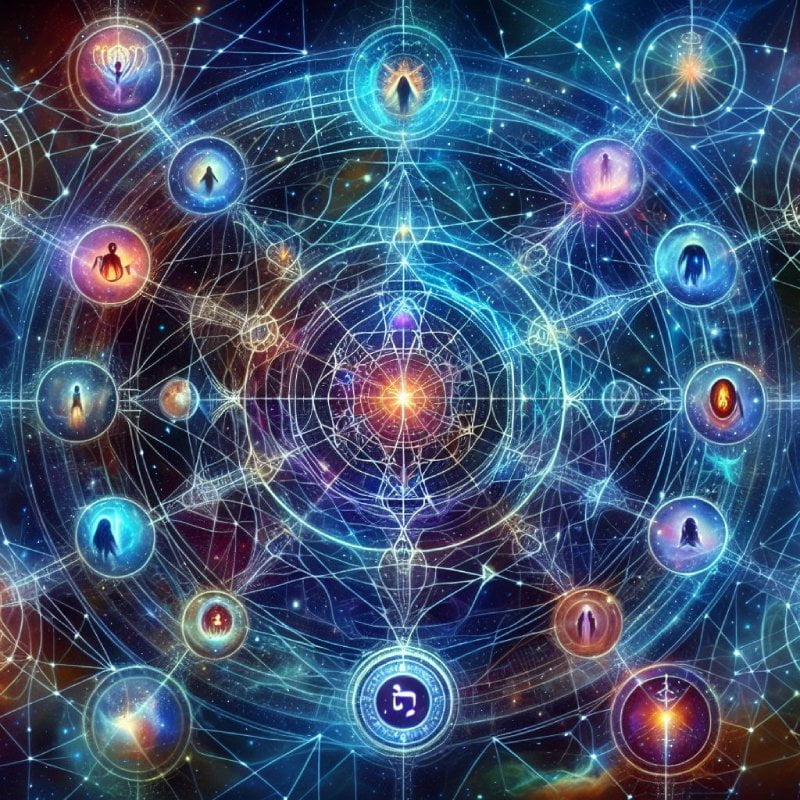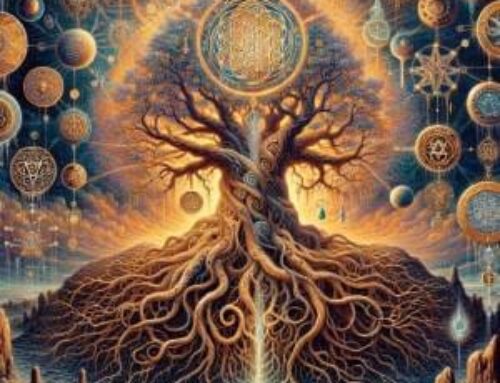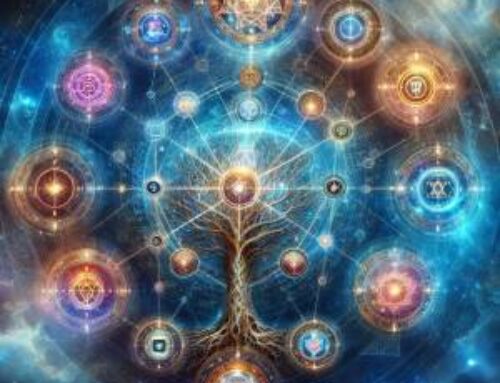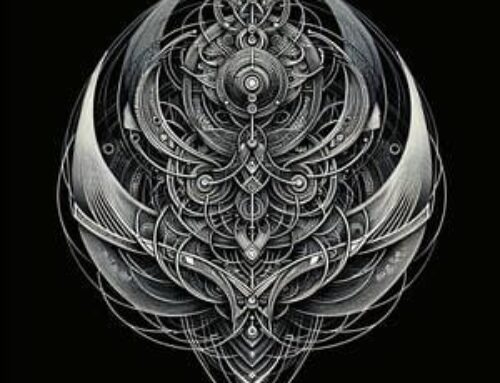Contents
Introduction to Kabbalah Qliphoth
In the shadowed realms of mystical wisdom, the “Kabbalah Qliphoth” stands as a profound concept, often shrouded in the veils of esoteric understanding. This exploration into the Qliphoth—literally ‘shells’ or ‘husks’ in Hebrew—delves deep into the inverted tree of life, where the roots touch upon not the celestial spheres, but rather, the chthonic echoes of spiritual existence. Herein lies the realm where light does not diffuse; instead, it reveals the contours of darkness that are just as integral to our spiritual journey as the radiant Sephiroth. Exploring the Kabbalah Qliphoth provides a profound entryway into the shadowed realms of mysticism.

The study of the Qliphoth offers not merely an examination of the demonic or the malevolent, but rather, a necessary understanding of balance and duality within the cosmic order of Kabbalah. As we traverse these dark paths, we uncover not only the nature of evil but also its role as a catalyst in the pursuit of enlightenment and self-realization. This article seeks to unfold the veiled narratives of the Qliphoth, exploring their intricate relationships with the Tree of Life and their implications in contemporary Kabbalistic practice.
Conceptual Foundations of Qliphoth in Kabbalah
The Nature of the Qliphoth
The Kabbalah Qliphoth represent the inverse aspects of the divine emanations known as the Sephiroth. Within the entwined maze of Kabbalistic lore, the Qliphoth signify much more than mere infernal beings; they are the embodiment of the intricate dance of luminosity and obscurity within the cosmos. Termed as “shells” or “husks,” these entities encapsulate deep metaphysical and emblematic meanings. The teachings recount that in the act of creation, when divine brilliance sought to materialize through the Sephiroth, an imbalance led to the vessels meant to harness this light breaking apart, giving rise to the Qliphoth. These entities are not just remnants but dynamic forces that imprison the divine light’s sparks within their distorted configurations.
The Dualistic Nature of the Qliphoth
In Kabbalistic manuscripts, the Qliphoth are portrayed as essential counterparts to the Sephiroth, the sacred emanations of the Divine. Each Qliphoth inversely mirrors a Sephirah, establishing a shadowed domain where the divine traits are mirrored in their depraved and often malicious manifestations. For example, whereas the Sephirah Chesed is synonymous with mercy and kindness, its Qliphothic opposite pertains to harshness and adjudication, frequently represented as despotic or vindictive energies.
The Role of the Qliphoth in Spiritual Evolution
Engaging with the Qliphoth is a pivotal aspect of the spiritual progression within Kabbalah. These forces compel the aspirant to face and reconcile the shadow parts of their essence, promoting a more profound grasp of the balance between light and darkness in the universe. This interaction is vital for attaining an all-encompassing insight into both the divine and oneself, rendering the Qliphoth indispensable in the pursuit of spiritual illumination.
The Dynamics of Evil and Its Spheres
The Symmetry of Light and Shadow
In the grand tapestry of Kabbalistic wisdom, the dynamics of the Qliphoth articulate a profound dialectic between the forces of light and darkness. Each Qliphoth acts as a counterforce to a Sephirah, presenting not merely an absence of good but a necessary polarity that defines and deepens the understanding of the Sephiroth themselves. The Qliphoth, thus, are not outcast or forgotten aspects of the divine schema; they are essential in maintaining the balance of the cosmic equilibrium. Each entity within the Kabbalah Qliphoth mirrors a specific Sephirah, revealing the intricate balance of cosmic forces.
The Qliphothic Reflections
As mirrors darkly reflecting the holy emanations, the Qliphoth invert the divine virtues into vices. Where Kether, the crown of pure divine intent, radiates unbounded will, its shadow, Thaumiel, splits this singularity into a duality of opposition, fostering division and conflict. This mirroring extends down the Tree of Life, from the highest to the lowest, illustrating that the spiritual path encompasses not only ascension towards light but also a navigation through the shadow.
The Integration of Darkness
The path through the Qliphoth is one of integration rather than avoidance. The wisdom of Kabbalah teaches that enlightenment arises from understanding all aspects of existence, including the most obscured. Thus, the practitioner who ventures into the realms of the Qliphoth seeks to reclaim and transform the scattered sparks of holiness trapped within these husks. It is a journey requiring courage, discernment, and the alchemical transmutation of darkness into light.
The Role of the Qliphoth in Cosmic Harmony
Each Qliphoth serves as a guardian of its corresponding virtue, challenging the seeker to overcome or understand its perversion. This process is crucial for the spiritual adept, for in conquering or integrating the lessons of the Qliphoth, one achieves a harmonious state of being that encompasses the full spectrum of divine creation. Herein lies the secret wisdom of Kabbalah: that true holiness involves the reconciliation of opposites, leading to a transcendent unity.
Spiritual Implications of the Qliphoth
The Inner Journey Through Darkness
In the labyrinthine passages of Kabbalistic mysticism, the Qliphoth represent not mere obstacles but essential stages in the soul’s pilgrimage towards enlightenment. These ‘shells’ or ‘husks’ offer the seeker profound insights into the nature of spiritual decay and redemption. Engagement with the Kabbalah Qliphoth is essential for anyone seeking a comprehensive understanding of spiritual depth and complexity. Each Qliphothic sphere, corresponding inversely to the Sephiroth, challenges the adept to confront and integrate aspects of the self that are obscured, neglected, or denied.
Transformation Through Adversity
The Qliphoth, as the shadow side of the Tree of Life, serve a critical role in the alchemical transmutation of the soul. They embody the principle that true spiritual growth is achieved not only through the ascent into light but through the descent into darkness. By engaging with these forces, the seeker encounters the raw materials of personal transformation—those aspects of the psyche that must be understood and redeemed. Contemporary interpretations of the Kabbalah Qliphoth continue to evolve, offering new insights into this timeless wisdom.
Redeeming the Sparks of Holiness
The doctrine of the Qliphoth teaches that within each sphere of darkness lie trapped sparks of divine light, remnants of the shattered vessels of creation. The task of the Kabbalist is to liberate these sparks through acts of spiritual rectification and integration. This process, known as ‘tikkun’, involves the restoration of balance and harmony within the self and the cosmos, thus fulfilling the purpose of the soul’s descent into the material world.
Ethical and Moral Considerations
The study and contemplation of the Qliphoth also serve as a moral compass for the practitioner, illuminating the consequences of ethical failings and the potential for redemption. Each Qliphothic realm provides a cautionary tale about the perversion of divine attributes and offers guidance on how to navigate the moral complexities of life. This aspect of Kabbalah encourages the adept to cultivate discernment, compassion, and integrity as they journey through both the light and shadow of existence.
Conclusion
In the mystic shadows cast by the Qliphoth, we find not just a repository of spiritual dangers, but a profound curriculum for the soul’s advancement. The journey into the Qliphoth is one of the most challenging yet transformative paths within Kabbalistic practice, offering a unique perspective on the nature of evil, the process of redemption, and the integral balance of cosmic forces. The journey through the Kabbalah Qliphoth challenges and enriches practitioners, deepening their spiritual journeys.
The exploration of the Qliphoth reveals that darkness is not merely to be feared or avoided, but understood and integrated. This acknowledgment of the Qliphoth challenges simplistic notions of good versus evil, urging us to perceive these forces as essential components of a holistic spiritual reality. In doing so, it calls on us to embrace the full spectrum of existence in our quest for divine knowledge. Those drawn to the mysteries of the Kabbalah Qliphoth can find further enlightenment through dedicated study and meditation in the Hermetic Academy.
Kabbalistic Secrets and Methods
For those drawn to the profound mysteries of Kabbalah, the study of the Qliphoth offers a deep well of wisdom. It is an invitation to venture beyond the surface of spiritual practice and to confront the complexities of existence head-on. Those who are ready to expand their understanding and embrace the challenge are encouraged to delve deeper into the Hermetic arts, where further secrets and methods await the earnest seeker.
FAQ – Kabbalah Qliphoth
1. What are the Qliphoth in Kabbalah?
A: The Qliphoth, often referred to as the “shells” or “husks” in Kabbalistic mysticism, represent the inverse attributes of the divine Sephiroth. They encapsulate the forces of chaos and impurity, acting as necessary counterparts to the forces of order and purity within the Tree of Life.
2. How do the Qliphoth relate to the Sephiroth in Kabbalistic cosmology?
A: Each Qliphah corresponds inversely to a specific Sephirah on the Tree of Life, forming a shadow realm that reflects distorted aspects of the divine attributes. This relationship highlights the dual nature of spiritual reality, emphasizing the balance between light and darkness within the cosmos.
3.Why is it important to study the Qliphoth in Kabbalistic practice?
A: Studying the Qliphoth is crucial for understanding the full spectrum of creation and spiritual forces. This engagement helps practitioners confront and integrate their shadow aspects, fostering a deeper understanding of themselves and the divine, which is essential for holistic spiritual development.
4. Can engaging with the Qliphoth enhance personal spiritual growth?
A: Yes, engaging with the Qliphoth challenges individuals to face and transform the darker aspects of their psyche. This transformative journey is vital for achieving spiritual enlightenment, as it involves reconciling the inner conflicts and integrating the lessons learned from these adversarial forces.
5. Where can one learn more about the intricacies of the Qliphoth and Kabbalah?
A: The Hermetic Academy offers a wealth of resources and teachings on Kabbalah. Aspiring students and practitioners are encouraged to explore these resources to gain a more comprehensive understanding of Kabbalistic wisdom and its practical applications in spiritual practice.
References:
(1) Mathers, S. L. M. (1887). The Kabbalah Unveiled. London.
(2) Mathers, S. L. M. (1887). The Kabbalah Unveiled. London,
(3) Mathers, S. L. M. (1887). The Kabbalah Unveiled. London.
(4) Rubenstein, E. (2020). The Tree of Life: The Kabbalah of Immortality. Hermetic World, Paphos.





